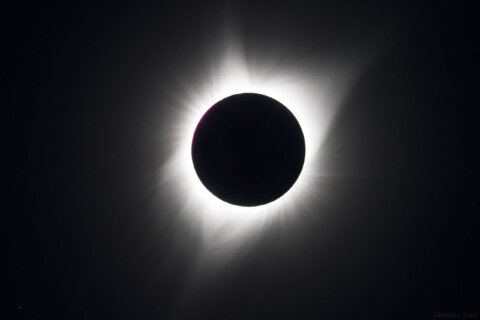▶ Watch Video: NASA launches $2.4 billion mission to search for signs of ancient life on Mars
The United Arab Emirates’ Hope spacecraft, the first interplanetary probe launched by an Arab nation, is on course to brake into orbit around Mars Tuesday, kicking off an ambitious mission to probe the red planet’s atmosphere and provide a “moonshot moment” for the youth of the Middle East.
It is the first of three Mars missions to reach the fourth planet from the sun this month. Next will be China’s ambitious Tianwen-1 orbiter-rover combination, expected to enter orbit Wednesday, and then NASA’s $2.4 billion Perseverance rover, expected to land on an ancient crater lakebed next Thursday.
But the UAE’s $200 million Hope, or Al Amal, probe was first off the pad, courtesy of a Japanese H-2A rocket last July 19, and the first to reach its target after a seven-month voyage spanning more than 300 million miles.

If successful, UAE will join the handful of nations that have undertaken interplanetary exploration and in so doing, inspire the next generation in the region.
“One of our mission objectives was to stimulate a lot of students and the entire society within STEM,” said deputy project manager Sarah Al Amiri, UAE minister of state for advanced sciences and chair of the Mohammed Bin Rashid Space Center.
“We’ve seen a large shift with the mindset of students, first and foremost within the Emirates, but we’ve also seen a lot of keen engagement with the region … and that has triggered a lot of thoughts with regards to what is possible, and how to be able to use the talents of youth positively rather than using them towards destruction.”
Hope’s moment of truth will come around 10:30 a.m. EST Tuesday, at an altitude of just 1,470 miles above Mars, when its thrusters ignite for a nerve-wracking 27-minute “burn,” slowing the craft enough to slip into an elliptical “capture orbit” with a low point around 620 miles and a high point of nearly 31,000 miles.
The spacecraft later will be maneuvered into its planned science orbit, measuring 12,400 by 26,700 miles, giving its three science instruments — a high-resolution camera and two sophisticated spectrometers — a global view of the martian atmosphere around the clock, in daylight and darkness.
Hope was built in the United States by Emirates engineers working at the Laboratory for Atmospheric and Space Physics at the University of Colorado at Boulder, with participation by Arizona State University and the University of California at Berkeley.
Over the course of at least one martian year — 687 days, or 1.8 Earth years — Hope will monitor weather systems in the lower atmosphere, study how atmospheric oxygen and hydrogen escape into space and collect data on processes in the lower atmosphere that contribute to that escape.

The Hope data will complement other Mars missions, shedding fresh light on how Mars changed from a warm, wet world with an atmosphere thick enough to permit liquid water on the surface, to the dry, frigid world seen today.
But science is just one of the mission’s goals.
“The objective was basically to use this mission to cause a disruptive change in the mindset of the youth, to create a research and development culture to support the creation of an innovative and creative and a competitive knowledge-based economy,” Omran Sharaf, the Hope project manager, said before launch.
“So it’s about the future of our economy. It’s about the post-oil economy. (UAE leadership) wanted to inspire the young generation to go into STEM and use this mission as a catalyst to cause disruptive change and shifts in multiple sectors. … That’s why they went with the Mars shot. (They) wanted to create an ecosystem that basically supports the creation of an advanced science and technology sector.”
Back-to-back Mars missions
Hope will remain in orbit throughout its mission. China’s Tianwen-1 features both an orbiter and a rover that will be deployed later. NASA’s Perseverance will plunge directly to the surface.
Equipped with seven instruments, Tianwen-1 is targeting an elliptical orbit around the poles of Mars that will carry the spacecraft within about 165 miles of the surface and as far away as 7,450 miles.
After mapping the world below for several months, the orbiter will release a landing craft that will descend to a rocket-powered touchdown on a broad, 2,000-mile-wide plain known as Utopia Planitia.
Perseverance, the most technologically complex and scientifically ambitious spacecraft ever launched to Mars, will descend directly into Jezero crater, lowered to touchdown by a rocket-powered “sky crane” descent vehicle.
The nuclear-powered rover is equipped with a battery of sophisticated instruments designed to look for signs of past microbial life in and around the rocky remnants of an ancient river channel and delta that once fed a body of water the size of Lake Tahoe.
It also carries an experimental drone-like helicopter — Ingenuity — that will attempt the first powered flight from the surface of another world and a technology demonstration experiment to extract oxygen from the thin martian atmosphere.
Perseverance will collect promising soil and rock samples, package them into small tubes and place them on the surface for eventual retrieval by another lander that will pick them up and launch back to orbit for handoff to another spacecraft that will carry them back to Earth.







